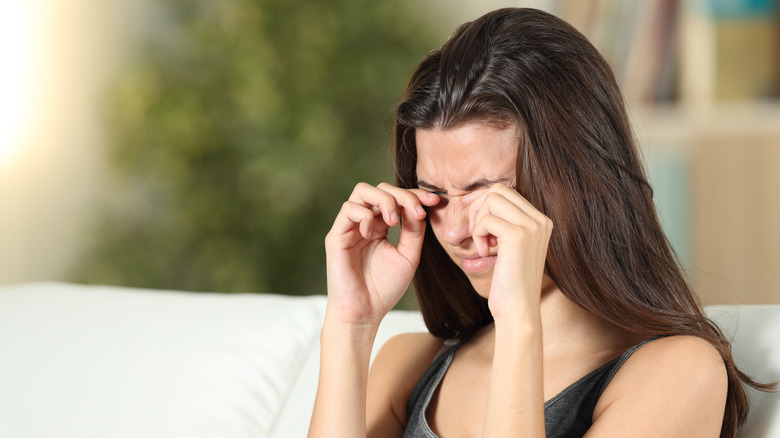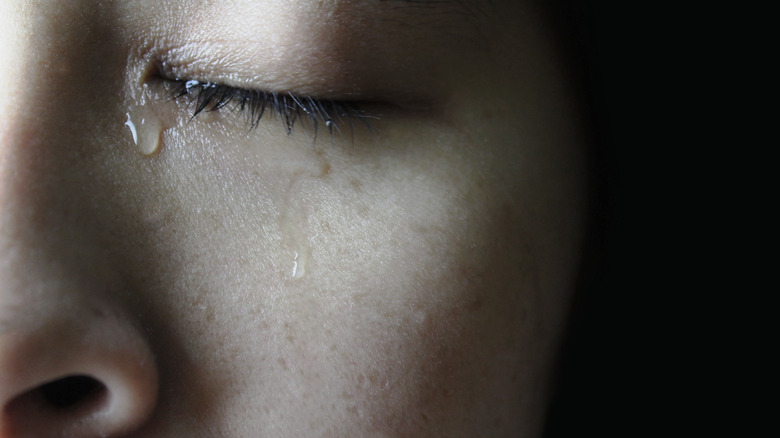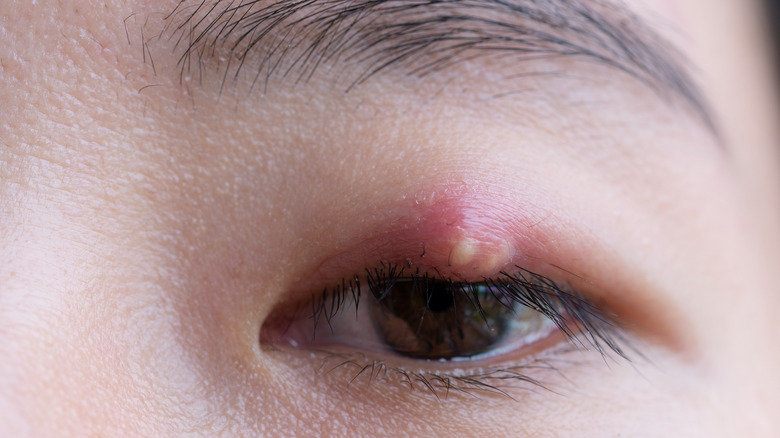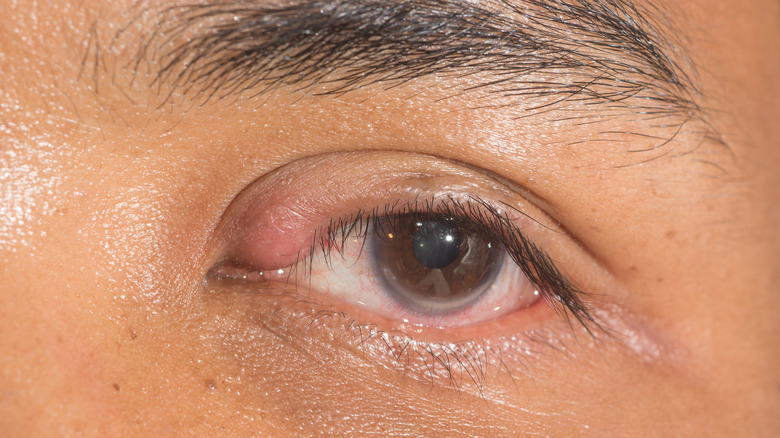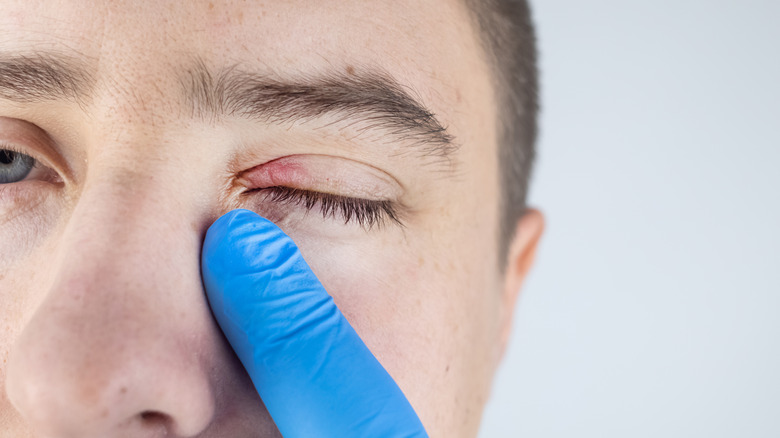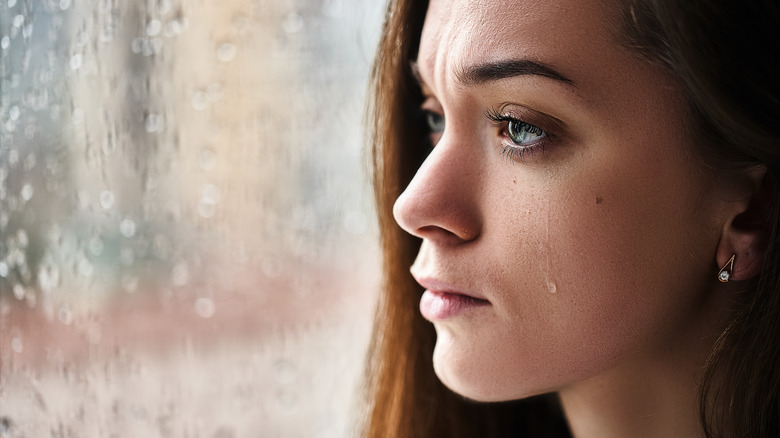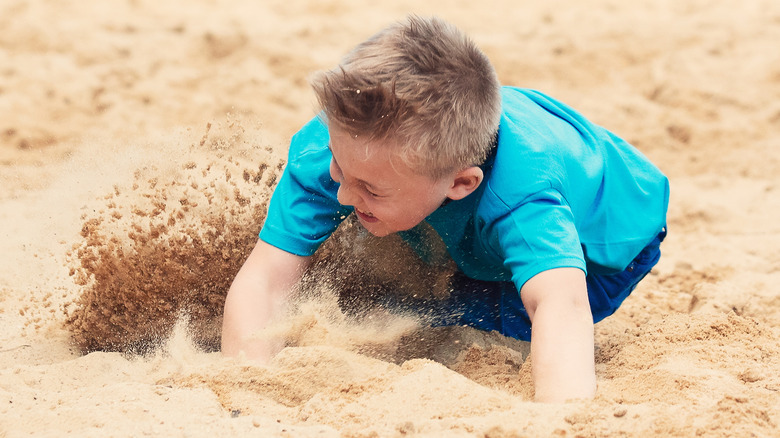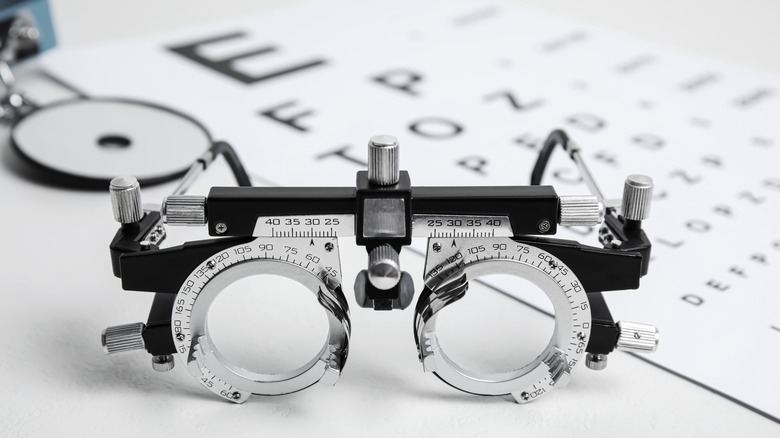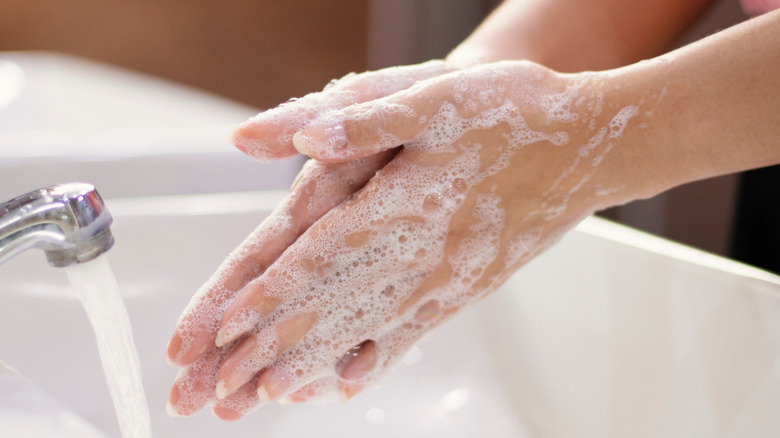What It Really Means When The Corner Of Your Eye Hurts
Allergies, dusty boxes, windy days at the beach. Most people have, at some point in their lives, experienced eye irritation. A little rubbing or a quick flush with saline solution usually clears it up and we can go about our day.
But sometimes that's not the end of the story. That dirt or dust might have left a small scratch before we cleared it out. Or, worse yet, there was no dirt or dust. One day, seemingly out of the blue, the corner of your eye may have started to hurt — and no amount of rubbing or saline solution could get it to stop.
In most cases when the corner of your eye hurts, it comes down to one of two reasons — sties or blocked tear ducts — but there are a few other possible causes. Let's dive into what might be causing your eye pain, what you can do about it, and when you should see your ophthalmologist for treatment.
How to know if it's a blocked tear duct
Pain in the inner corner of your eye is often caused by a blocked tear duct. Blocked tear ducts usually occur when the tear ducts become infected (known as dacryocystitis), narrow due to age and become more prone to blockage, sustain an injury, or when certain medical treatments affect the duct's health (such as prescription eye drops or chemotherapy). Recurring tear duct blockages may also be a sign of a tumor inside the nose or along the tear drainage system. If you regularly experience blocked tear ducts, please consult a doctor.
According to the Mayo Clinic, there are unfortunately no home remedies for a blocked tear duct. A doctor may prescribe antibiotics or other medication, but generally healing is a matter of waiting out the infection. There are, however, ways to reduce your risk of reinfection. The most impactful of these is to wash your hands before touching your eyes. Another is to avoid sharing makeup and to regularly replace your eye makeup, especially after suffering an infection. And, finally, if you wear contacts, make sure they are kept clean according to the manufacturer's suggestions.
Recognizing and treating styes
Styes, which are caused by infected glands in the eyelid, are painful, swollen bumps — sometimes with a white head like a pimple or boil — that usually appear near the lash line (via Mayo Clinic). Unlike blocked tear ducts, styes, which can be internal or external, can often be helped by certain home remedies. The Cleveland Clinic suggests applying a warm wet washcloth to the sty's location for 10 to 15 minutes about three to five times a day. Before you apply the towel, however, make sure you wring out as much water as possible so the cloth remains warm but is not soaked. You can also wipe away any drainage using eyelid wipes or a very gentle solution of Johnson's baby shampoo and water.
It's important to note that you should never pop a sty. It may look like a pimple, but it will not behave like one. As Healthline says, popping a sty may spread the infection and may cause pitting or scars. Most styes will clear up within a few days, but if the pain persists or the swelling spreads, definitely see a doctor.
Chalazion versus sties
Although a chalazion and a stye can look similar, as the Cleveland Clinic explains, they're not the same thing. While both styes and chalazia form when an oil gland inside one of the eyelids becomes blocked, styes form because of an infection developing in the gland (per Cleveland Clinic). A chalazion can form even if no infection is present.
Since both styes and chalazia are bumps on the eyelid, it can be difficult to tell them apart. But a big difference between the two is whether or not the bump on your eyelid hurts. Styes are usually painful, while chalazia tend not to be painful. Also, a chalazion usually forms farther back on one's eyelid than a stye, and it tends to appear on the upper eyelid more often than the lower lid. Regardless of whether it's located on the upper or lower eyelid, a large chalazion can cause blurry vision if it pushes against the eyeball.
While a chalazion can be unpleasant, there are some dos and don'ts for helping one heal more quickly. According to the Cleveland Clinic, warm compresses for 15 minutes three or more times a day can help unblock the oil gland. Carefully and gently massaging one's eyelid can also speed up recovery time. However, if you have a chalazion, you should never try to pop it. You should also refrain from wearing makeup until the chalazion has completely gone away.
Blepharitis
It's probably not surprising that you have oil glands on the top of your scalp. But did you known that you have oil glands located by your eyelashes? And if you develop blepharitis, these glands can become clogged and cause the edge of your lids to become red and irritated, per Mayo Clinic.
While we're still learning why some people develop blepharitis, patterns have emerged pointing to possible connections between different circumstances/conditions and this eyelid-related health issue. For example, if the oil glands in the eyelids are not working properly, that might increase the chances of someone developing blepharitis. An allergic reaction to things like makeup, certain medications, and contact lens solution might also lead to blepharitis. Infections, dry eye, and rosacea all seem to also raise one's chances of having blepharitis, as does dandruff located on the scalp or in the eyebrows. In addition, lice or mites in one's eyelashes and blepharitis might go hand in hand.
Besides causing inflammation on the edge of the eyelids, blepharitis can also make the eyelids swollen and itchy. Additionally, someone with blepharitis can have crusty eyelashes, might blink more often than usual, and may have red, watery eyes. Some symptoms are painful or uncomfortable. A person with blepharitis might say that their eyes are burning or stinging, or they might feel like they constantly have something gritty in their eyes.
Punctal stenosis
It's easy to understand this condition once you break down its name. As Dr. Christopher Zoumalan, a board-certified cosmetic eyelid surgeon, explains on his website, the "punctal" in punctal stenosis comes from the medical term "puncta," which is the opening of the tear duct system. You have a puncta in the inner corner of each eyelid (via American Academy of Ophthalmology). "Stenosis" is when something becomes narrower than usual. So, punctal stenosis is when an opening to the tear duct system becomes narrower, which makes it harder for tears to flow out of that opening normally.
According to Dr. Zoumalan, there are a number of health concerns that can lead to punctal stenosis. These include eyelid malposition. Just like ill-fitting shoes can be unpleasant and even damaging to your feet, your eyelids need to "fit" your eyes properly or they can cause pain and injury to your eye, per Stanford Health Care. Besides malpositioned eyelids, Dr. Zoumalan notes that punctal stenosis can occur because of eyelid neoplasms. And as the National Cancer Institute states, neoplasms are another name for tumors. Also, Healthline explains that the punctum can narrow with age, which can increase the chances of the tear ducts becoming blocked. And once the tear ducts are blocked, a person can experience both swelling and pain in the inner corners of their eyes.
Pinguecula and pterygium
If you like to surf, you want to be aware of these next two eye conditions. According to Johns Hopkins Medicine, sometimes a person might notice the side of their eye has a small white or yellow growth. This is known as a pinguecula, and as the American Academy of Ophthalmology (AAO) explains, it typically (but not always) happens on the inner side of the eye (the part closest to your nose). Unfortunately, not only can this growth make it harder for tears to properly coat your eye, but it can also develop into a pterygium, or what is sometimes called surfer's eye.
As Johns Hopkins notes, pterygiums are also raised growths like pingueculas, but they are long enough to reach the cornea — the clear part of the eye that goes over the pupil and the iris. So, a pterygium can impact one's vision by altering the shape of the cornea. In addition, a person with a pterygium can have irritated, red eyes.
Although a pinguecula and a pterygium aren't the same, ultraviolet radiation like the kind in sunlight can cause both of these conditions, per Johns Hopkins. Also, constantly getting particles of dirt in your eyes and wind blowing in your face could up your chances of developing a pterygium (via Laser Eye Center). In fact, the reason why pterygium is called surfer's eye is because a surfer's eyes are more like to regularly be exposed to sunlight, dirt, and wind.
What to do when something is in your eye
While watery eyes can be annoying, tears are extremely useful because they flush things like dirt and clothing fibers out of your eye (via WebMD). But what should you do if the tears don't seem to be helping fast enough?
Well, let's use the example of a common but potentially damaging substance that is likely to at some point get in your eye: sand. According to Healthline, one of the worst things you can do if you have sand in your eye is to rub the area. Even though sand might not seem sharp, it still has the potential to scratch your eye, especially if you rub it. And if something scratches the cornea, it could cause a corneal abrasion, which in turn can lead to pain and vision issues (via Corneal Abrasion). Additionally, a scratched cornea has the potential to become infected, per Cureus.
Besides not rubbing your eye, Healthline states that you shouldn't try to remove anything from your eye with a tweezers or a cotton swab. Instead, WebMD recommends getting a mirror and opening your eye as wide as you can, so you can determine what's in your eye and exactly where it's located. You might also want to immerse your eye in an eye cup filled with saline or clean water and blink to help your eye expel whatever is in it.
When should you go to the doctor?
Sometimes an eye issue will improve on its own. For example, your eye could become irritated and watery if an irritant like an eyelash gets in it, but once that irritant is out, your eye should start feeling better (via Healthline). However, there are some red flags that indicate it's time to seek medical help for your eyes.
Remember, pain is your body's way of letting you know that something is wrong. And when you're experiencing pain in the corner of your eye that either worsens or doesn't lessen, you should contact a medical professional, per Healthline. So, using the above scenario with the eyelash, if your eye doesn't improve or becomes worse even after the eyelash is out, that could mean something else is wrong with your eye. Also, you should call 9-1-1 if the pain in the corner of your eye is severe, if blood or pus is coming out of your eye, if your vision becomes blurry, or if you lose your vision. Additional signs of an emergency include swelling, light sensitivity, problems moving your eye around, and difficulty opening your eye.
Furthermore, the Mayo Clinic recommends calling for emergency medical help if you have eye pain and are also experiencing an elevated body temperature, nausea, vomiting, and/or headaches. Other symptoms that could point to a eye-related medical emergency (besides the ones listed above) include seeing halos around sources of light (if it happens abruptly and out-of-the-blue), as well as abrupt changes in vision.
Prevention
Certain eye care actions are all but common sense. It's not hard to understand that constantly touching your eyes, especially if you don't properly wash your hands, can be a recipe for eye problems, via KLM Eye MDs. However, while we focus on our eyes (and rightfully so), it's important that we not forget about our eyelids.
Fortunately, cleaning your eyelids is easy to work into your everyday self-care routine. First, talk with your eye doctor about what cleaning solutions are safe to use on your eyelids (per Eyes On Norbeck). Then after washing your hands, put that solution on a clean washcloth. Starting with either the left or the right eye, carefully wipe both the margin of that eye's lids, as well as the eyelashes. Rinse the solution off with warm water and repeat the process with a fresh, clean washcloth for the other eye.
In addition to keeping your eyelids clean, it's important to completely remove eye makeup. As Eyes On Norbeck points out, not doing so can lead to bacteria growing on the eyelids, which can cause other eye problems. Also, KLM Eye MDs advises never sharing cosmetics, towels, washcloths, or bedding. Also, since your glasses — whether they're sunglasses or otherwise — are very near your eyes, they too need to be cleaned regularly. And one final note: Proper contact lens care is crucial for good eye health.

